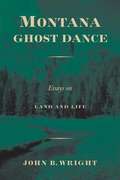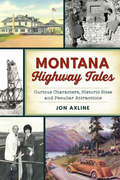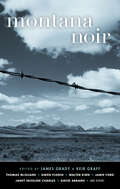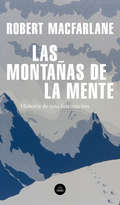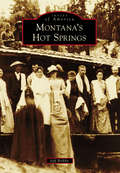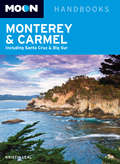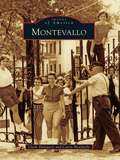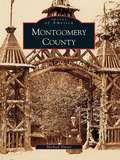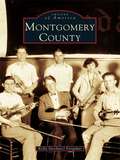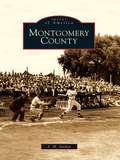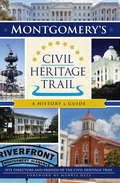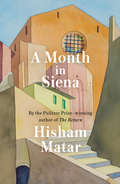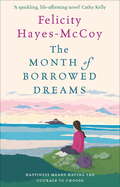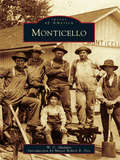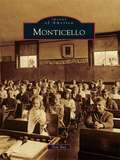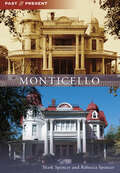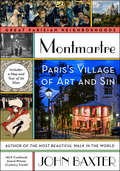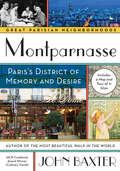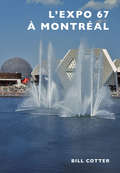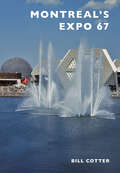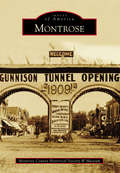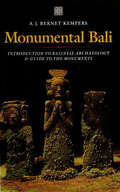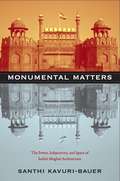- Table View
- List View
Montana Ghost Dance: Essays on Land and Life
by John B. WrightMontana has been the last best place for so many people. A century ago, Native Americans gathered here to perform the Ghost Dance--a last, doomed attempt to make white settlers vanish and bring back the old ways of life. Today, people are still pouring into Montana, looking for the pristine wilderness they saw in A River Runs through It. The reality of Montana--indeed, of all the West--has never matched the myths, but this book eloquently explores how the search for a perfect place is driving growth, development, and resource exploitation in Big Sky country. In ten personal essays, John Wright looks at such things as Montana myths; old-timers; immigrants; elk; ways of seeing the landscape; land conservation and land trusts; the fate of the Blackfoot, Bitterroot, and Paradise valleys; and some means of preserving the last, best places. These reflections offer a way of understanding Montana that goes far beyond the headlines about militia groups and celebrities' ranches. Montana never was or will be a pristine wilderness, but Wright believes that much can be saved if natives and newcomers alike see what stands to be lost. His book is a wake-up call, not a ghost dance.
Montana Highway Tales: Curious Characters, Historic Sites and Peculiar Attractions (History & Guide)
by Jon AxlineMuch of Montana's exciting history is visible from its storied highways. Visit a segment of the historic Bozeman Trail overlooking Virginia City, where vigilantes hanged public nuisance Joseph Alfred Slade just as his wife attempted a horseback rescue. Discover the saga of adultery, attempted murder and eventual triumph that occurred at a single stone building in the Browns Gulch area of Butte. On Highway 308 east of Red Lodge, learn more about the tragic 1943 Smith Mine disaster, where a methane explosion trapped and killed seventy-three miners. The catastrophe triggered investigations at the state and national level that resulted in improvements in mine safety. With more than two dozen stories, historian Jon Axline provides a front-seat view of the Treasure State's thrilling past, forgotten characters and overlooked oddities found by the wayside.
Montana Noir (Akashic Noir)
by David Abrams Caroline Patterson Eric Heidle Janet Skeslien Charles Sidner Larson Yvonne Seng James Grady Jamie Ford Carrie La Seur Walter Kirn Thomas McGuane Gwen Florio Debra Magpie Earling Keir GraffEric Heidle's "Ace in the Hole" nominated for a 2018 Edgar Award for Best Short Story!A Parade magazine pick, included in "Books We Love" section"What could be a more unlikely breeding ground for noir fiction than Montana, whose wide-open landscapes seem the polar opposite of the mean streets of Los Angeles? Yet certain noir standbys prove both malleable and fertile in these 14 new stories...If Montana has a dark side, is anywhere safe from noir?"--Kirkus Reviews"Terrific...Montana Noir is one of the high points in Akashic's long-running and justly celebrated Noir series...Editors Grady and Graff's selections...are all sharply attuned to their settings and to the ways those varying landscapes reflect the darkness within the people who walk the streets or drive the country roads."--Booklist"14 stories set in Big Sky Country. Much like a travel map that divides Montana into regions, this volume is partitioned into four sections that reflect the geography of the state: Copper Power, The Hi-Line, Custer Country, and Rivers Run...Montana, and others live in the state; all the authors have strong emotional ties to the area's particular lifestyle. The editors tout this book as the first-ever anthology of Montana-set noir short stories. Fans of the genre and regional fiction will be intrigued."--Library Journal XPress Reviews"There's no shortage of misbehavior in this book. But there's also no shortage of excellent writing by some of Montana's finest authors. The book included work by Thomas McGuane, Jamie Ford, Walter Kirn, Debra Magpie earling and eight others. Thwey're all Montanans, every one, and their subjects are as varied and unique as the state itself."--Montana Quarterly"Even though Montana's beauty makes the idea of dark alleys and neon lights seem incongruous, noir also represents struggle, and doing the wrong thing for the right reasons...There can never be a happy ending in noir but there can be the possibility of redemption. It's the little guy against big forces and as Montanans, we can all appreciate that fight."--Billings GazetteAkashic Books continues its award-winning series of original noir anthologies, launched in 2004 with Brooklyn Noir. Each book comprises all new stories, each one set in a distinct location within the geographic area of the book. Grady and Graff, both Montana natives, masterfully curate this collection of hard-edged Western tales.Brand-new stories by: David Abrams, Caroline Patterson, Eric Heidle, Thomas McGuane, Janet Skeslien Charles, Sidner Larson, Yvonne Seng, James Grady, Jamie Ford, Carrie La Seur, Walter Kirn, Gwen Florio, Debra Magpie Earling, and Keir Graff.From the introduction by James Grady and Keir Graff:This anthology is a road trip through the dreams and disasters of the true Montana, stories written by authors with Montana in their blood, tales that circle you around the state through its cities and small towns. These are twenty-first century authors writing timeless sagas of choice, crime, and consequences...You'll meet students and strippers, cops and cons, druggies and dreamers, cold-eyed killers and caught-in-their-gunsights screwed-up souls.But mostly, through all our fiction here, you'll meet quiet heroes and see the noir side of life that makes our Montana as real as it is mythic. No doubt the state's beauty will still make the very idea of Montana Noir seem incongruous to some. Noir is black-and-white. Streets and alleys. Flashing neon lighting a rain-streaked window. But while noir was definitely an urban invention, it knows no boundaries. Noir is struggle. It's doing the wrong thing for the right reasons. It's being trapped. It's hubris. It's being defeated yet going on. Sometimes it's being defeated and not going on.That's life everywhere. This is our Montana.
Las montañas de la mente: Historia de una fascinación
by Robert MacfarlaneRobert Macfarlane nos invita a subir la mirada hacia las montañas, en este apasionante viaje cultural por la historia de nuestra fascinación por ellas. Galardonado con The Guardian First Book Award y libro del año según The New York Times. «Hay muchos libros sobre montañismo y montañeros, pero este es uno de los mejores y menos convencionales que he leído.» The Times ¿Cómo y cuándo las montañas pasaron de ser barreras peligrosas e infranqueables, habitadas por bestias y dragones, a suscitar los anhelos más aventureros de quienes se atreven a conquistarlas, incluso poniendo en riesgo sus vidas? Las montañas de la mente es un apasionante viaje cultural a través de la historia de nuestra fascinación por estas moles de piedra y hielo. Robert Macfarlane nos brinda interesantes referencias literarias e históricas que acompaña con las evocadoras descripciones de sus propios ascensos, investiga los descubrimientos geológicos y los fenómenos naturales que atrajeron a los primeros exploradores, e intenta comprender el irrefrenable deseo por lo desconocido, el poder de las alturas y las cimas a través de las ideas de aquellos personajes que, a lo largo de las décadas, contribuyeron a forjar el actual imaginario colectivo. Este libro, que es ya un clásico para los amantes de la montaña y la naturaleza, no trata, en palabras del autor, «de nombres, fechas, picos y alturas, como los libros al uso sobre la montaña, sino de sensaciones, emociones e ideas. En realidad, no es un libro sobre montañismo sino un libro sobre la imaginación». La crítica ha dicho...«Maravillosamente iluminador [...] Una estimulante combinación de aventura y academia, que demuestra una erudición deslumbrante del autor, sus agudos poderes de análisis, un pulido sentido de la historia cultural y una demostración apasionada de la dedicación con la que trata el tema.»Los Angeles Times «Fascinante, con una premisa inteligente.»The New York Times Book Review «Los montañeros de antaño se quedaron sin palabras para describir el esplendor de las montañas, pero Robert Macfarlane las encuentra.»The Times Literary Supplement «De todos los libros que se publicaron para conmemorar el 50 aniversario del ascenso al Monte Everest, Las montañas de la mente , de Robert Macfarlane, destaca por ser el libro másinteligente e interesante de lejos... con un estilo que demuestra que puede ser poético y osado a la vez.»The Economist «Un trabajo fascinante de historia y, a la vez, una meditación bellamente escrita sobre cómo la memoria, la imaginación y el paisaje de las montañas se unen en nuestras mentes y bajo nuestros pies.»Forbes «Una nueva manera de escribir sobre la exploración, supone quizá el nacimiento de un nuevo género, que no solo desafía la clasificación, si no que demanda toda una nueva categoría en sí misma.»The Telegraph
Montana's Hot Springs (Images of America)
by Jeff BirkbyMontana's hot springs and hot water resorts bubble with fascinating histories of medical cures, Native American legends, glittering spas, and isolated wilderness soaks. These Montana hot springs provided soothing cures for the aches and pains of Native Americans and early Montana pioneers. A few of the crude bathhouses built by miners and settlers gave way to ornate bathing resorts, replete with some of the most elegant furnishings and facilities available between Minneapolis and San Francisco, from the 1890s through the 1920s. Grand hot springs resorts--including Corwin Hot Springs, Boulder Hot Springs, Hunter's Hot Springs, and Broadwater Hot Springs--flourished and then faded from Montana's landscape. Through photographs, Images of America: Montana's Hot Springs explores the stories and legends of hot-water bathing resorts in Montana.
Monterey & Carmel
by Kristin LealJournalist and Monterey Bay area resident Kristin Leal offers her firsthand experience and advice on Monterey, Carmel, and beyond, from Fisherman’s Wharf and Cannery Row to the nearby areas of Pacific Grove and Salinas. Leal includes various travel itinerary ideas, including Family Fun in Santa Cruz, Charmed in Carmel-by-the-Sea, and Visit Early California—a guide to the best antiques shops and Mexican restaurants San Juan Bautista has to offer. Complete with expert tips on wandering the redwoods in the Santa Cruz mountains, finding hidden waterfalls in Big Sur, and spotting otters at the Elkhorn Slough National Reserve,Moon Monterey & Carmelgives travelers the tools they need to create a more personal and memorable experience.
Montevallo
by Carey Heatherly Clark HultquistMontevallo: a mountain in a valley. This bucolic, natural phrase aptly describes the beauty of this central Alabama town. Early settlers were drawn to the area by its abundant agricultural and mineral resources, and in 1826, the tiny village of Montevallo was born. The nature of the town changed significantly in 1896 with the founding of the Alabama Girls' Industrial School, now the University of Montevallo. The Olmsted Brothers firm of Brookline, Massachusetts, laid out the central campus, and its master plan still inspires current development. Since 1896, the focus of the town has shifted from agriculture and mining to education. The university's mission is to be Alabama's "Public Liberal Arts College." Prominent figures include writer and veteran E. B. Sledge, actresses Polly Holliday and Rebecca Luker, and Major League Baseball player Rusty Greer.
Montgomery County
by Michael DwyerNicknamed the "Gateway to the Nation's Capital," Montgomery County is home to a number of federal agencies and a highly educated and affluent population that has grown increasingly diverse in recent years. Established in 1776, Montgomery County now consists of urban centers like Bethesda and Silver Spring; suburban neighborhoods like Wheaton, Germantown, and Potomac; and scenic rolling farmland interspersed with historic villages, like Brookeville and Barnesville. An additional 50,000 acres of federal, state, and county parkland provide numerous recreational opportunities for its residents.
Montgomery County
by Kelly Yacobucci FarquharWith a rich and varied history spanning almost three hundred years, Montgomery County suffered during the Revolutionary War, prospered with the Erie Canal and the railroad, and changed in the age of urban renewal. Located in the heart of the Mohawk Valley in upstate New York, the county experienced the arrival of Dutch and Palatine German settlers, the passage of travelers heading west through the Noses, the pre-suffragist sojourn of Susan B. Anthony, and the swift success of the carpet industry. All of this is compellingly retold in Montgomery County, a broad look at the people, industry, culture, and architecture that make up the county's history.
Montgomery County
by S. M. SendenMontgomery County was one of the last areas in Iowa to be settled. For many years it was considered to be uninhabitable and of little value-until the men and women with hopes and dreams began to settle, build towns, and till the rich, fertile soil. The Forks, Binn's Grove, Hungry Hollow, Frankfort, Milford, Red Oak Junction, Stanton, Villisca, and many more settlements came into being, budding with promise, but the coming of the railroad determined the survival of them all. Some are still thriving cities, while others are no more than a fading memory that only the winds of the prairie can recall.
Montgomery's Civil Heritage Trail: A History & Guide (Landmarks)
by Morris Dees Friends Of Trail Site DirectorsMontgomery's cultural heritage reflects two of America's most transformative struggles: the Civil War and the civil rights movement. On February 18, 1861, Jefferson Davis was inaugurated as president of the Confederate States of America on the Alabama Capitol steps. Those same steps marked the final destination of the Selma-Montgomery voting rights march on March 25, 1965. The telegram to fire on Fort Sumter originated from the Winter Building on Court Square on April 11, 1861. Just down the street, and a century later, Mrs. Rosa L. Parks refused to give up her seat, sparking the Montgomery Bus Boycott. Discover these compelling stories and more surrounding the historical landmarks along Montgomery's Civil Heritage Trail.
A Month in Siena
by Hisham MatarFrom the Pulitzer Prize–winning author of The Return comes a profoundly moving contemplation of the relationship between art and life. After finishing his powerful memoir The Return, Hisham Matar, seeking solace and pleasure, traveled to Siena, Italy. Always finding comfort and clarity in great art, Matar immersed himself in eight significant works from the Sienese School of painting, which flourished from the thirteenth to the fifteenth centuries. Artists he had admired throughout his life, including Duccio and Ambrogio Lorenzetti, evoke earlier engagements he’d had with works by Caravaggio and Poussin, and the personal experiences that surrounded those moments.Including beautiful full-color reproductions of the artworks, A Month in Siena is about what occurred between Matar, those paintings, and the city. That month would be an extraordinary period in the writer’s life: an exploration of how art can console and disturb in equal measure, as well as an intimate encounter with a city and its inhabitants. This is a gorgeous meditation on how centuries-old art can illuminate our own inner landscape—current relationships, long-lasting love, grief, intimacy, and solitude—and shed further light on the present world around us.Praise for A Month in Siena“As exquisitely structured as The Return, driven by desire, yearning, loss, illuminated by the kindness of strangers. A Month in Siena is a triumph.”—Peter Carey
The Month of Borrowed Dreams: A feel-good summer novel (Finfarran #4)
by Felicity Hayes-McCoyFinfarran Book 4'A sparkling, life-affirming novel -- sunshine on the page' Cathy KellySummer is on its way, and Lissbeg librarian Hanna Casey has started a club showing films based on popular novels. But soon the club's members find dramatic twists and turns happening in their own lives on Ireland's west coast.Hanna's daughter Jazz finally feels like she can call Lissbeg home. But when her life is turned upside down, will she return to London to make a fresh start?Aideen is afraid that her romance with Conor won't survive the pressures of their planned double wedding with overbearing Eileen and manipulative Joe. Meanwhile, Saira Khan is determined to help a troubled new arrival to Finfarran.And could Hanna's own newfound happiness to Brian be threatened by the return of her ex-husband Malcolm?As the club prepares for the first meeting of the summer, they'll all face hard choices. But will they get the happy endings they deserve?'A heartwarming novel' Irish Independent
Monticello
by Mayor Robert Fox W. C. MaddenMonticello was founded by the White County commissioners in 1834 on a bluff above the Tippecanoe River. They named it after the mansion ofThomas Jefferson, the third president of the United States. It was incorporated as a town in 1862. The county seat grew more rapidly when the railroads cameto town before the Civil War. Then the town grew large enough to become a city in 1909, and a mayor was elected. The area around the city became atourist destination in the 1920s after dams created the twin lakes--Shafer and Freeman--and Ideal Beach was conceived. It was renamed Indiana Beach in the 1950s and became the largest entertainment park in the state. In 1974, a devastating tornado roared through downtown Monticello, killing eight people and destroying a large part of the city. However, the people of Monticello banded together to reconstruct a stronger community. Today the city of Monticello is a thriving, progressive community growing in population and size. About a milliontourists come to the area each summer to relax and have fun.
Monticello
by Tom RueLatin for "heavenly mountain," Monticello's founders supported Thomas Jefferson's populist ideals, naming their village for his Virginia home. Center of the Town of Thompson and seat of Sullivan County since 1809, Monticello was founded in 1804 and incorporated in 1830 by John and Samuel Jones. Tanning, lumbering, farming, and manufacturing gave way to tourism. The railroad came in 1871. A fire in 1909 decimated the downtown, but automobiles and an artery nicknamed "the Quickway" connected New York City to the mountains and made Monticello a recreation center. The years 1920 to 1930 saw a population increase of 48 percent. Sidewalks brimmed with shoppers as Broadway, lined with stately and beautiful shade trees, clattered with traffic at all hours. Slightly over an hour from Manhattan, Monticello had two identities: a community built and sustained by workers, residents, and businesses and a busy "borscht belt" vacation center of boardinghouses, hotels, bungalows, and recreation.
Monticello (Past and Present)
by Mark Spencer Rebecca SpencerThe 1872 French castle courthouse set the tone for construction in Monticello. Numerous elegant churches, residences, schools, and civic buildings followed.
Montmartre: Paris's Village of Art and Sin
by John BaxterIn the second portrait of his series Great Parisian Neighborhoods, award-winning raconteur John Baxter leads us on a whirlwind tour of Montmartre, the hill-top village that fired the greatest achievements of modern art while also provoking bloody revolution and the sexual misbehavior that made Paris synonymous with sinHigh on the northern edge of Paris, Montmartre has always attracted bohemians, political radicals, the searchers for artistic inspiration as well as those hungry for pleasure. In its winding, windmill-shadowed streets, which, only fifty years before, saw the anarchist rising of the Commune, Renoir, Picasso and van Gogh seized a similar freedom to remake painting, while, in the tenderloin of Pigalle, Toulouse-Lautrec drew the cancan dancers of the Moulin Rouge, celebrating a hedonism that titillated the world, In Montmartre, bestselling author and IACP Award winner John Baxter lifts the curtain on a district that visitors to Paris seldom see. From the tumbledown workshops of the Bateau Lavoir in which Picasso and Braque created Cubism to Clichy's Cabaret of Nothingness where guests dined at coffins under lamps of human bones, the whole of this mysterious enclave is ours to explore.For visitors and armchair travelers alike, Montmartre captures the excitement and scandal of a fascinating quarter that condenses the elusive perfumes, colors and songs of Paris.
Montparnasse: Paris's District of Memory and Desire
by John BaxterIn the third portrait of his series Great Parisian Neighborhoods, award-winning raconteur John Baxter takes readers on a dazzling excursion of Montparnasse.By the IACP Award-winning author of the national bestseller The Most Beautiful Walk in the World, MONTPARNASSE reveals the history and present delights of the iconic neighborhood that is best associated with the vibrant 1920-30s-era Paris—a romantic time and place evoked in Hemingway's memoir A Moveable Feast and Henry Miller's Tropic of Cancer. From the first meeting of Hemingway and F. Scott Fitzgerald to their friendship's bitter conclusion; from the courage of the anti-Nazi resistance to the clubs where German generals partied; from the attempted murder of Samuel Beckett to the rise of Josephine Baker to stardom; from the high life of the Coupole and the Cafe du Dôme to the bawdy music halls of rue de la Gaité; no Paris quarter has witnessed more tumultuous events than Montparnasse.In a ground-breaking reappraisal of this most glamorous of Paris's districts, Baxter looks beyond the nostalgia to the secret history of Montparnasse, a district where desire effaced memory and every taste could be satisfied—even those which were unexpressed. If, as Oscar Wilde suggested, all good Americans went to Paris when they died, it was Montparnasse that brought them back to life.
Montreal's Expo 67
by Bill CotterEn 1967, le Canada fêtait le centième anniversaire de son existence avec une fête spectaculaire, et tout le monde a été invité. L'Expo 67 de Montréal était la première exposition internationale à avoir lieu au Canada et c'était une grande réussite, qui a attiré plus de 50 millions de visiteurs. Le site de 405 hectares a été construit sur deux îles artificielles dans le fleuve Saint-Laurent et incorporait 90 pavillons d'aspects futuristes, créés par les meilleurs architectes et concepteurs dans le monde. Plus de 60 pays y ont été représentés ainsi que des pavillons privés, corporatifs et thématiques. Tous ont fait partie du thème « Terre des Hommes ». Avec des artistes de tous les secteurs, des restaurants, des attractions culturelles, des expositions et un parc d'amusement de classe internationale, l'Expo 67 était en réalité la fête du siècle et elle a dépassé toutes les attentes.
Montreal's Expo 67
by Bill CotterIn 1967, Canada celebrated the 100th anniversary of its founding with a spectacular party, and the whole world was invited. Montreal's Expo 67 was the first world's fair held in Canada, and it was a huge success, attracting over 50 million visitors. The 1,000-acre site was built on two man-made islands in the St. Lawrence River and incorporated 90 futuristic pavilions created by some of the world's greatest architects and designers. Over 60 countries were represented, along with many private, corporate and thematic pavilions, all brought together under the theme "Man and his World." With performers and entertainers of all varieties, restaurants, cultural attractions, exhibitions and a world-class amusement park, Expo 67 was literally the party of the century, exceeding all expectations.
Montrose (Images of America)
by Montrose County Historical Society & MuseumThe narrow-gauge Denver & Rio Grande (D&RG) Railroad, the first rail system to challenge and successfully conquer Colorado’s Rocky Mountains, arrived in the Uncompahgre (un-cum-PAH-gray) Valley on the state’s western slope in 1882. Montrose was established to supply mines in the mineral-rich San Juan Mountains and provide a freight transfer depot and a shipping point for gold and silver ore. The US government had forced the Ute Indians off their traditional lands the previous year and opened the area to settlement. Land was quickly claimed and cleared as the booming mining districts created a ready market for all agricultural produce. By the 1893 repeal of the Sherman Silver Act and the US economic decline, Montrose was well established, but continued growth revealed a serious need for supplemental water. Selected as an inaugural project by the newly created US Bureau of Reclamation, the resulting Gunnison Tunnel has provided water since 1909.
Monumental Bali
by A.J. Bernet KempersMonumental Bali describes a formative period in Balinese history through a study of the island's fascinating antiquities. This classic work provides the key to understanding Bali's most famous monuments, including the "Elephant Cave" near Ubud, the "Royal Tombs" at Gunung Kawi, and the spectacular "Mother Temple" at Besakih. A comprehensive Guide to the Monuments section containing detailed maps, site diagrams, and over one hundred beautiful color photographs, will prove indispensible to the serious visitor.
Monumental Bali
by A.J. Bernet KempersMonumental Bali describes a formative period in Balinese history through a study of the island's fascinating antiquities. This classic work provides the key to understanding Bali's most famous monuments, including the "Elephant Cave" near Ubud, the "Royal Tombs" at Gunung Kawi, and the spectacular "Mother Temple" at Besakih. A comprehensive Guide to the Monuments section containing detailed maps, site diagrams, and over one hundred beautiful color photographs, will prove indispensible to the serious visitor.
Monumental Bali
by A.J. Bernet KempersMonumental Bali describes a formative period in Balinese history through a study of the island's fascinating antiquities. This classic work provides the key to understanding Bali's most famous monuments, including the "Elephant Cave" near Ubud, the "Royal Tombs" at Gunung Kawi, and the spectacular "Mother Temple" at Besakih. A comprehensive Guide to the Monuments section contains:Detailed MapsSite DiagramsOver one Hundred Beautiful Color PhotographsIn 1956 Dr. and Mrs. Bernet Kempers returned to the Netherlands and began working in both Indonesian and European studies. Between 1958 and 1971, Dr. Bernet Kempers was director of the Netherlands Open Air Museum in Amhem, and was for a time professor of European Ethnology at the University of Amsterdam. Between 1970 and 1948 he revised Indonesian (including Bali) regularly in connection with research into ancient monuments and archaeological preservation.Monumental Bali will not only be informative, but will also take the reader into the history behind each fascinating place found in province and islands of Bali.
Monumental Matters: The Power, Subjectivity, and Space of India's Mughal Architecture
by Santhi Kavuri-BauerBuilt in the sixteenth and seventeenth centuries, India's Mughal monuments--including majestic forts, mosques, palaces, and tombs, such as the Taj Mahal--are world renowned for their grandeur and association with the Mughals, the powerful Islamic empire that once ruled most of the subcontinent. In Monumental Matters, Santhi Kavuri-Bauer focuses on the prominent role of Mughal architecture in the construction and contestation of the Indian national landscape. She examines the representation and eventual preservation of the monuments, from their disrepair in the colonial past to their present status as protected heritage sites. Drawing on theories of power, subjectivity, and space, Kavuri-Bauer's interdisciplinary analysis encompasses Urdu poetry, British landscape painting, imperial archaeological surveys, Indian Muslim identity, and British tourism, as well as postcolonial nation building, World Heritage designations, and conservation mandates. Since Independence, the state has attempted to construct a narrative of Mughal monuments as symbols of a unified, secular nation. Yet modern-day sectarian violence at these sites continues to suggest that India's Mughal monuments remain the transformative spaces--of social ordering, identity formation, and national reinvention--that they have been for centuries.
